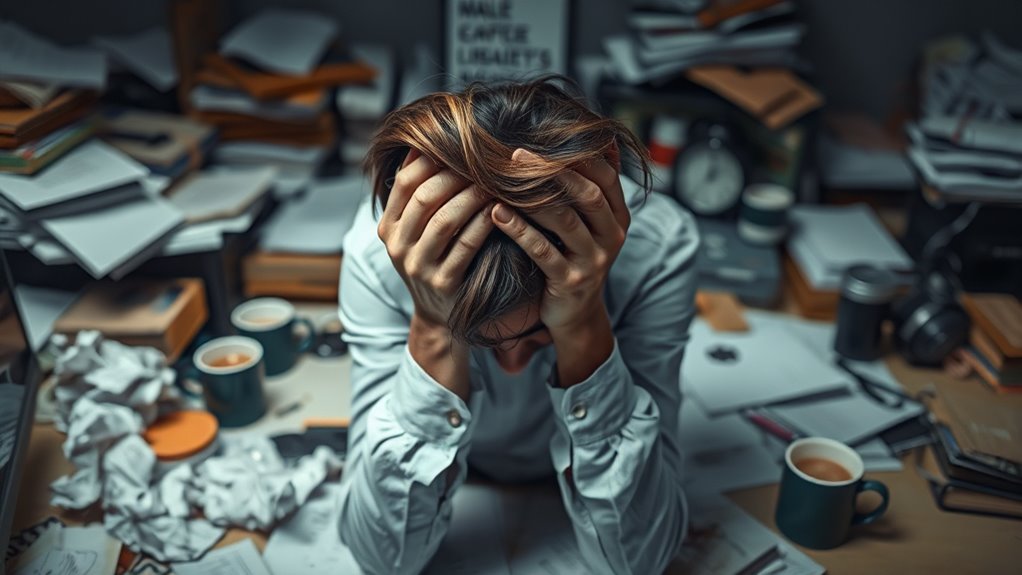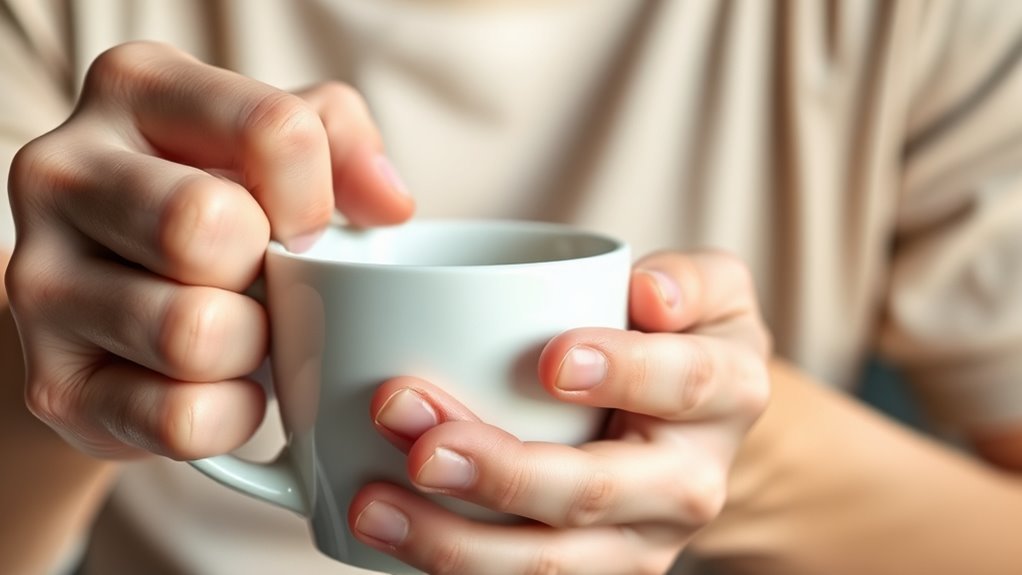Stress is your body’s normal response to immediate demands, causing physical symptoms like a racing heart and tension. Anxiety, however, is feelings of worry or fear that persist longer, sometimes without clear triggers, and can lead to ongoing mental and physical effects. Recognizing whether you’re experiencing short-term stress or lingering anxiety helps you manage them better. Understanding these differences can empower you to improve your mental health—continue exploring to learn more about managing both.
Key Takeaways
- Stress is a temporary physical and emotional response to external demands; anxiety is a persistent worry often without clear triggers.
- Stress activates the fight or flight response, causing symptoms like rapid heartbeat; anxiety involves ongoing dread, muscle tension, and racing thoughts.
- Stress typically resolves quickly once the situation passes, while anxiety can last weeks or months if untreated.
- External factors like deadlines trigger stress; internal feelings like fear or self-doubt often trigger anxiety.
- Recognizing early signs helps manage stress with relaxation techniques; addressing anxiety may require ongoing coping strategies and professional support.
Defining Stress and Its Causes

Stress is your body’s natural response to demands or challenges, signaling that something requires your attention. When you face a tight deadline, an argument, or a big change, your body reacts by releasing hormones like adrenaline and cortisol. These chemicals prepare you to respond quickly, increasing your heart rate, sharpening your focus, and boosting your energy. While this response can be useful in short bursts, ongoing stress can wear you down physically and mentally. Causes of stress vary widely; they include work pressure, relationship issues, financial worries, and health concerns. Recognizing these triggers helps you understand what’s pushing your buttons and allows you to take steps to manage or reduce stress before it affects your well-being. Understanding how stress impacts your body can motivate you to adopt healthier coping strategies.
Understanding Anxiety and Its Origins

Anxiety is a feeling of unease or worry that often arises in response to perceived threats or uncertainties. It’s your mind’s way of alerting you to potential dangers, even if they aren’t immediately present. Anxiety can stem from past experiences, genetics, or environmental factors, shaping how you react to stressors. Sometimes, it develops without a clear trigger, becoming a persistent part of your life. Your brain’s amygdala, responsible for processing fear, overreacts in some cases, fueling anxious feelings. While it’s a natural response meant to keep you safe, when it becomes overwhelming or frequent, it can interfere with daily activities. Understanding where anxiety originates helps you recognize its patterns and manage it more effectively. Additionally, anxiety triggers can vary widely among individuals, making personalized approaches essential for effective coping strategies.
Physical Reactions to Stress

When you experience stress, your body activates the fight or flight response, preparing you to react quickly. This triggers physical symptoms like rapid heartbeat, sweating, or tense muscles. At the same time, hormonal changes occur, intensifying these reactions and affecting your overall state. Recognizing these physical reactions to stress can help you better manage your response and maintain your well-being.
Fight or Flight Response
The fight or flight response is your body’s immediate reaction to a perceived threat, preparing you to confront or escape danger. When you sense danger, your brain signals your adrenal glands to release adrenaline and cortisol, fueling your body. Your heart rate increases, pumping blood faster to your muscles, giving you strength and speed. Breathing speeds up to supply more oxygen, helping you stay alert. Pupils dilate to improve your vision, and blood flow shifts from digestion to muscles. You might also notice your skin flushes or your senses sharpen. These physical reactions are designed to help you respond quickly, whether that means fighting the threat or fleeing from it. Additionally, understanding headphone connection types can help you better utilize audio devices in emergency or stressful situations. Basically, your body primes itself to protect you from harm in moments of danger.
Physical Symptoms Manifestation
Stress triggers a variety of physical symptoms that your body exhibits as it reacts to perceived threats. You might notice your heart pounding, rapid breathing, or muscle tension. These reactions prepare you to act but can also lead to discomfort if prolonged. Common symptoms include headaches, sweating, and gastrointestinal issues. To better understand, here’s a quick overview:
| Symptom | Effect | Body Part |
|---|---|---|
| Increased Heart Rate | Pumps blood faster for alertness | Heart |
| Muscle Tension | Feels tight or sore | Muscles |
| Rapid Breathing | Supplies oxygen quickly | Lungs |
| Sweating | Cools your body | Skin |
| Digestive Changes | Nausea or upset stomach | Gut |
These physical signs are your body’s way of signaling stress, often without your immediate awareness. Additionally, stress can sometimes lead to air quality issues that further impact your health.
Hormonal Changes Activation
As your body perceives a threat, it activates hormonal responses that prepare you to confront or escape the danger. Your brain signals the release of adrenaline from the adrenal glands, causing your heart rate to increase and your muscles to tighten. Simultaneously, the hypothalamus triggers the release of cortisol, the primary stress hormone, which provides a quick energy boost by increasing glucose in your bloodstream. This hormonal surge sharpens your senses and heightens alertness, enabling rapid reactions. These changes are designed to help you respond effectively to immediate threats. However, if stress persists, sustained hormonal activation can lead to physical and mental health issues. Understanding the hormonal response involved in stress helps you recognize how your body reacts and why managing it is vital.
Psychological Manifestations of Anxiety

You might notice persistent worry patterns that keep looping in your mind, making it hard to focus. You become more aware of physical sensations like a racing heart or tense muscles, which can heighten your anxiety. Sleep disruptions, such as trouble falling asleep or staying asleep, often signal psychological stress taking a toll on your well-being. Recognizing emotional and physical signs early can help in managing anxiety more effectively.
Persistent Worry Patterns
Persistent worry is a hallmark psychological manifestation of anxiety, often taking the form of relentless and intrusive thoughts about future events or potential problems. You might find yourself constantly ruminating on what could go wrong, unable to shake off these persistent concerns. This pattern can interfere with your daily life, making it difficult to focus or relax. You may notice that your mind jumps from one worry to another, creating a cycle of overthinking. These worries often feel uncontrollable, even when you recognize they may be exaggerated or unlikely. Over time, this persistent pattern reinforces feelings of dread, causing emotional exhaustion. Recognizing these worry patterns is vital to understanding how anxiety manifests psychologically and can guide you toward seeking appropriate support or coping strategies. Additionally, understanding persistent worry can help differentiate between normal concern and clinically significant anxiety that may require intervention.
Physical Sensation Awareness
Although persistent worries dominate the mental landscape of anxiety, its physical sensations reveal another, equally important side of the experience. You might notice your heart pounding, palms sweating, or muscles tensing without any clear reason. Breathing may become rapid or shallow, making you feel short of breath. Some people experience a tightness in the chest or a sensation of dizziness. These physical signs are your body’s response to stress hormones, preparing you for a perceived threat. By becoming aware of these sensations, you can better recognize anxiety’s presence early on. Instead of ignoring or suppressing these feelings, acknowledge them calmly. This awareness helps you understand that these sensations are temporary and manageable, empowering you to respond with relaxation techniques rather than panic. Recognizing psychological manifestations of anxiety alongside physical sensations enables a more comprehensive approach to managing your response.
Sleep Disruptions Signs
Sleep disruptions are common psychological signs of anxiety, often signaling that your mind is overwhelmed or racing. When anxiety takes hold, your thoughts can spin uncontrollably, making it hard to fall asleep or stay asleep. You might find yourself waking up suddenly in the middle of the night or experiencing restless sleep that leaves you tired and irritable during the day. These disruptions can also include racing thoughts or an inability to quiet your mind, even when you’re physically exhausted. Over time, this pattern worsens, creating a cycle of stress and sleep deprivation. Recognizing these signs early helps you address anxiety before it deeply impacts your mental health. Prioritizing relaxation techniques can improve your sleep and reduce anxiety’s psychological toll. Additionally, understanding the impact of sleep disturbances on mental health can motivate you to seek appropriate support.
Duration and Persistence of Each Condition

Stress often occurs as a temporary response to specific events or demands, typically lasting from a few hours to several days. Once the stressful situation passes, your body’s stress response usually diminishes, allowing you to return to normal. In contrast, anxiety tends to persist longer, often lasting weeks or even months if underlying issues aren’t addressed. You might find that anxiety lingers even after the initial trigger is gone, becoming a chronic state that affects your daily life. While stress is often linked to immediate challenges, anxiety can become a more persistent condition, sticking around without a clear end point. Recognizing these differences in duration can help you better understand your emotional health and seek appropriate support.
External Triggers vs. Internal Feelings

External triggers are specific events or situations that set off stress or anxiety, such as deadlines, conflicts, or emergencies. These are tangible, external factors that cause immediate reactions. In contrast, internal feelings stem from your thoughts, beliefs, or memories, often without an obvious external cause. Recognizing this difference helps you identify whether your distress originates from outside circumstances or your internal responses.
| External Triggers | Internal Feelings |
|---|---|
| Deadlines | Worry or self-doubt |
| Conflicts | Fear or guilt |
| Emergencies | Memories triggering anxiety |
| Sudden changes | Negative self-talk |
| Social pressures | Perfectionism or self-criticism |
Understanding whether triggers are external or internal guides your coping strategies effectively.
Recognizing Symptoms in Daily Life

Being able to recognize the symptoms of stress and anxiety in your daily life is crucial for managing them effectively. Notice if you feel overwhelmed, irritable, or constantly on edge—these are common signs of stress. Physical symptoms like rapid heartbeat, muscle tension, headaches, or stomach issues also point to stress or anxiety. You might find yourself avoiding social situations or struggling to concentrate. Feeling restless or having trouble sleeping are additional indicators. Pay attention to your emotional state; persistent worry, fear, or a sense of impending doom suggest anxiety. Recognizing these symptoms early helps you understand what you’re experiencing, so you can seek appropriate support or strategies to cope before they escalate.
Strategies for Managing Stress and Anxiety

Once you’ve identified the signs of stress and anxiety, taking proactive steps to manage them can make a significant difference. You should try techniques like deep breathing, exercise, or mindfulness to calm your mind and body. Consistent routines help create stability, reducing triggers. It’s also useful to set boundaries and prioritize tasks to avoid feeling overwhelmed. Consider the following strategies:
| Technique | Benefit | Example |
|---|---|---|
| Deep breathing | Reduces immediate tension | Practice for 5 minutes daily |
| Regular exercise | Boosts mood, relieves stress | Walk or jog outdoors |
| Mindfulness meditation | Enhances focus, relaxes mind | Use guided apps |
Applying these approaches can help you regain control and foster resilience against stress and anxiety.
Frequently Asked Questions
Can Stress and Anxiety Occur Simultaneously?
Yes, stress and anxiety can happen at the same time. When you’re overwhelmed by a stressful situation, your body might also react with anxiety, making you feel nervous or worried even after the stressor is gone. You might notice physical signs like a racing heart or sweating. Recognizing this overlap helps you manage both better, using relaxation techniques or seeking support to ease your feelings.
How Do I Differentiate Between Stress and Anxiety Symptoms?
Imagine you’re caught in a storm, feeling overwhelmed by waves crashing around you. To tell if it’s stress or anxiety, notice your body’s signals: stress often hits with a sudden jolt, like thunder, causing short-term discomfort. Anxiety, however, feels like an ongoing fog, lingering and making you worry about future storms. Pay attention to whether your feelings are temporary or persistent to tell them apart.
Are There Long-Term Health Risks Associated With Unmanaged Stress or Anxiety?
Unmanaged stress and anxiety can lead to serious long-term health risks. You might experience high blood pressure, heart disease, or weakened immune function if these feelings persist unchecked. Chronic stress can also cause mental health issues like depression or burnout. It’s important to address these feelings early by seeking support, practicing relaxation techniques, and making lifestyle changes to protect your overall well-being and prevent lasting health problems.
What Role Do Genetics Play in Developing Anxiety or Stress Disorders?
About 30-40% of anxiety disorders are linked to genetics, showing how your family history influences your risk. Genetics play a significant role in developing anxiety or stress disorders, as they affect brain chemistry and response to stress. If a close relative has experienced anxiety, you’re more likely to develop it too. While genetics set the stage, environmental factors and life experiences also shape how these conditions manifest in you.
When Should I Seek Professional Help for Stress or Anxiety?
If your stress or anxiety feels overwhelming, persistent, or starts affecting your daily life, it’s time to seek professional help. You should consider talking to a mental health expert if you notice difficulty sleeping, changes in appetite, or feelings of hopelessness. Don’t wait until things become unmanageable—getting support early can make a significant difference in managing your symptoms and improving your overall well-being.
Conclusion
Remember, understanding the difference between stress and anxiety is like knowing the difference between a storm and a shadow. While storms pass, shadows may linger, and recognizing them helps you find clarity and peace. By paying attention to your body’s signals and your mind’s whispers, you can navigate these challenges with courage. Like a lighthouse guiding ships safely home, awareness can lead you to calmer waters, empowering you to face each day with confidence.









